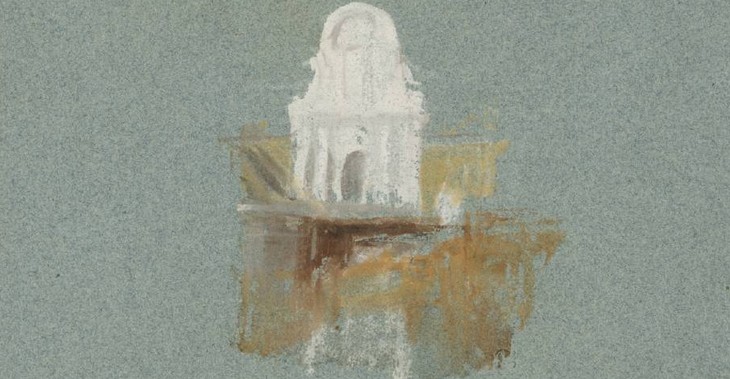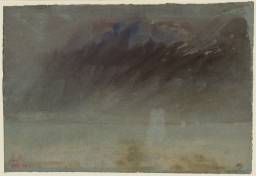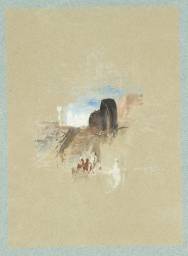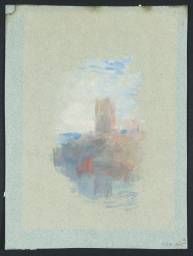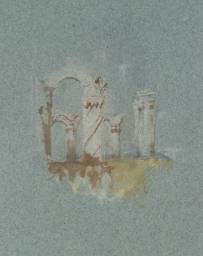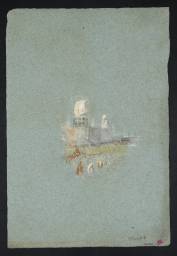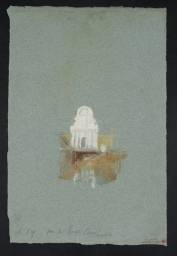From the entry
This section is comprised of six colour studies on blue paper believed to relate to an incomplete print series known as ‘Picturesque Views on the East Coast of England’. Eric Shanes and others have suggested this project followed Turner’s involvement in the Cooke brothers’ Picturesque Views on the Southern Coast of England, a print series issued between 1814 and 1826 (for colour studies in the Turner Bequest see the relevant section within the present publication). It seems that Turner disagreed with George and William Bernard Cooke over the details of a proposed ‘East Coast’series, and began creating drawings independently. He worked in watercolour and gouache on a blue paper support, which immediately distinguishes both the colour studies included here and the finished watercolours from those prepared for the Southern Coast. Turner similarly used a blue paper support when completing studies and finished watercolours for a different print project, published as ...
References
This section is comprised of six colour studies on blue paper believed to relate to an incomplete print series known as ‘Picturesque Views on the East Coast of England’. Eric Shanes and others have suggested this project followed Turner’s involvement in the Cooke brothers’ Picturesque Views on the Southern Coast of England,1 a print series issued between 1814 and 1826 (for colour studies in the Turner Bequest see the relevant section within the present publication). It seems that Turner disagreed with George and William Bernard Cooke over the details of a proposed ‘East Coast’series, and began creating drawings independently.2 He worked in watercolour and gouache on a blue paper support, which immediately distinguishes both the colour studies included here and the finished watercolours from those prepared for the Southern Coast. Turner similarly used a blue paper support when completing studies and finished watercolours for a different print project, published as Turner's Annual Tour (1833–5; later reissued as Rivers of France); the British and coastal subject matter of the studies included here differentiates them from those made for the Annual Tour.
Most of the finished watercolours for the ‘East Coast’, some of which were completed in vignette format, were engraved by James Charles Allen (1790?–1833), once a pupil and employee of William Bernard Cooke (1778–1855); the ‘East Coast’ views were his last prints for Turner.3 Five plates were completed as etchings and engravings, while another three remained in an incomplete etched state. None were published before the project was abandoned. For details of the finished vignettes and landscape watercolours, which include views of Lowestoft, Orford, Happisburgh Sands, Aldeburgh, Dunwich, Great Yarmouth and Whitby, see Wilton;4 an additional vignette entitled Great Yarmouth Fishing Boats (Stirling and Francine Clark Institute, Williamstown, Massachusetts) is also now considered part of the ‘East Coast’ series.5
An inscription on one of the sheets, ‘4 vig. For the East Coast’ (see individual entry for Tate D27627; Turner Bequest CCLXXX 110), along with consideration of the blue paper support and coastal subject matter, has seen the studies in this section associated with the ‘East Coast’ project. Eric Shanes also associated a number of additional sheets in the Bequest with the series (Tate D25170, D25194, D25370, D25452, D36228, D36261, D36276–D36279, D36281–D36288; Turner Bequest CCLXIII 48, 72, 248, 329; Turner Bequest CCCLXIV 366, 394, 408–411, 413–420).6 These currently sit in other groupings within the present publication: individual entries should be consulted for comments on tentative connections to ‘Picturesque Views on the East Coast of England’.
As the details and instigation of the assumed ‘East Coast’ series remain somewhat unclear, some alternative suggestions for the purpose of the finished drawings have been made. Historically they were known as ‘Holloway’s Continuation of England and Wales’ (Holloway being a one-time owner of the finished drawings and plates), associating the group with Turner’s Picturesque Views in England and Wales. This, however, is certainly misleading: it has long been accepted that the drawings are not connected to the England and Wales project, although this early mistake has caused some confusion in the literature.7 Jan Piggott, on the other hand, proposed that the prints were once intended as ‘Landscape Illustrations’ for a book of the life and poems of the Suffolk-born Reverend George Crabbe published by John Murray.8 The most compelling evidence in support of this theory, in addition to the East Anglia subject matter seen in most of the prints, is a note in the 1865 catalogue of Munro of Novar’s collection describing the vignettes Orford Haven and Lowestoffe Lighthouse (Pantzer Collection, Indianapolis Museum of Art9) as ‘Two Illustrations to Crabbe’.10 However, as firm evidence linking Turner to the Crabbe project has yet to be found the earlier assumption that the works relate to an incomplete ‘East Coast’ series is here upheld.
Turner had been sketching areas of England’s east coast for many years before 1827, the proposed date of the studies included in this section: he first visited Holy Island, the subject of one of the studies, in 1797, for example. For his completed ‘East Coast’drawings, though, he drew most significantly on his Norfolk, Suffolk and Essex sketchbook, dated to the summer of 1824 (Tate D18159–D18310, D41437–D41439; Turner Bequest CCIX 1–89a). This sketchbook documents visits to the coastal destinations of Orford, Aldeburgh, Dunwich, Walberswick, Southwold, Lowestoft, Great Yarmouth and Happisburgh; see the introduction to the sketchbook by Alice Rylance-Watson for more information about this tour. The only non-East Anglia subject actually engraved for the incomplete ‘East Coast’ scheme was a view of Whitby (untraced11), although some of the studies included here may hint at unrealised plans to include other subjects.
Hunnisett, B. (2204–09–23). Allen, James Charles (bap. 1790?. D. 1833), engraver. Oxford Dictionary of National Biography, accessed 27 February 2018, http://www.oxforddnb.com/view/10.1093/ref:odnb/9780198614128.001.0001/odnb-9780198614128-e-375 .
How to cite
Elizabeth Jacklin, ‘Colour Studies for ‘Picturesque Views on the East Coast of England’ c.1827’, August 2018, in David Blayney Brown (ed.), J.M.W. Turner: Sketchbooks, Drawings and Watercolours, Tate Research Publication, November 2019, https://www

